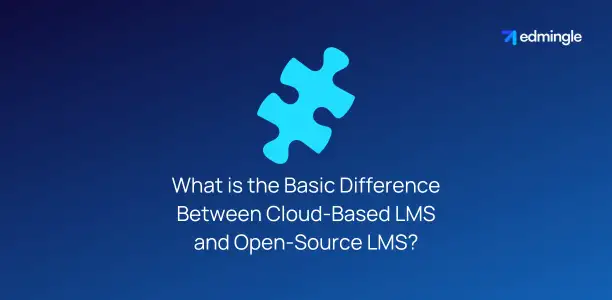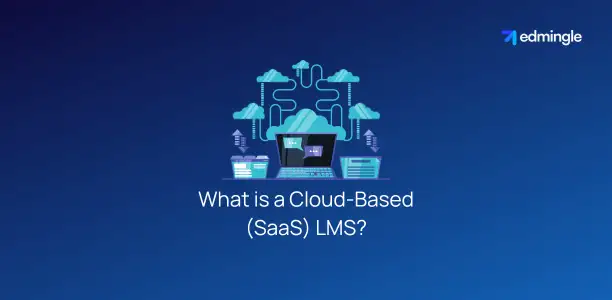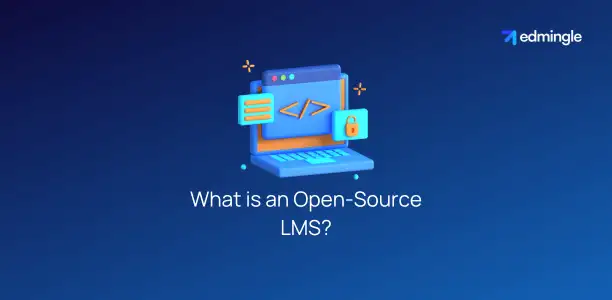
In the world of LMSs, this is a hotly debated question. A choice that presents a pivotal decision for educators, organizations, and businesses alike.
The difference between cloud based LMS vs open source LMS isn’t just about how they’re hosted. It goes deeper.
It’s an era of boundless online learning opportunities. Amidst this, understanding the nuances between these two types of LMS platforms becomes crucial.
And as we navigate this distinction in this blog. You’ll gain a deeper understanding of the difference between cloud-based LMS and open-source LMS.
What is the Basic Difference Between Cloud Based LMS and Open Source LMS?

The basic difference between cloud based LMS and open source LMS lies in their hosting. But this is not the end of the list.
The distinction also lies in their cost structure, customization capabilities and maintenance requirements.
While cloud-based learning management systems are hosted on the provider’s servers and accessed via the internet.
Open-source LMS platforms offer access to their source code. Hence, allowing organizations to host it anyway they want to.
To read more about LMS cost structures. Read our blog on LMS pricing.
What is a Cloud-Based (SaaS) LMS?

A cloud-based LMS is hosted on remote servers. These do not need for physical installations.
Since it can be accessed through the web via mobile devices, students and instructors can interact with the content from anywhere, at any time.
Benefits of Cloud-Based Learning Management Systems
| 1.Accessibility: Users can access the platform from anywhere with an internet connection. Thus, facilitating a flexible learning process. | 2.Cost-Efficiency: Reduces the need for extensive IT infrastructure, lowering upfront costs. Read how Edmingle helps reduce your operational cost by 20%. |
| 3.Scalability: Easily scales to accommodate more users or courses. Without the need for additional hardware. | 4.Rapid Deployment: Can be quickly set up and made operational. Thereby, minimizing downtime. |
| 5.Maintenance and Updates: Handled by the service provider. It ensures the platform remains up-to-date with the latest features and security measures. For instance, modern SaaS LMSs come with robust tools to track learner progress. |
Limitations of a Cloud-Based LMS
- Limited Customization: May offer less flexibility in customization.
- Dependence on Internet Connectivity: Requires a stable internet connection for access.
- Data Security Concerns: Storing sensitive information off-site may raise concerns about data privacy and security.
- Recurring Costs: Subscription-based pricing models can become costly over time.
If you’re worried about limited customization in a cloud-based LMS. Check our blog on Edmingle White-Labelling.
5 Top Cloud-Based LMS of 2024
| 1.Edmingle | 2.Canvas | 3.Blackboard | 4.Absorb LMS | 5.TalentLMS |
What is an Open-Source LMS?

An open-source LMS is publicly available via its original source code.
This allows organizations to customize, modify and distribute the software. According to their specific needs. It provides the ultimate flexibility and control over the entire learning environment.
Benefits of Open-Source Learning Management Systems
| 1.High Customizability: Offers the freedom to tailor the learning platform extensively. To read more about this, check our blog on white label LMS platforms. | 2.Cost-Effectiveness: With no license fees. It can be a more affordable option in the long run. |
| 3.Community Support: Benefits from a global and collaborative community of developers contributing updates and plugins. | 4.Ownership of Data: Allows organizations to host their data on-premise. Thus, offering greater control over security. |
Limitations of an Open-Source LMS
- Technical Expertise Required: Implementation and maintenance require significant IT skills.
- Higher Initial Setup Costs: Potential costs for customization, hosting, and ongoing maintenance.
- Time-Consuming: Customization and deployment can be more time-intensive. When compared to cloud-based solutions.
Read about Edmingle Scalability and Flexibility to know how it’s better than an open-source LMS.
5 Top Open-Source LMS of 2024
| 1.Moodle | 2.Open edX | 3.Sakai | 4.Chamilo | 5.Totara Learn |
Key Difference Between Cloud Based and Open Source LMS
The table below outlines the key differences between cloud based LMS and open source LMS. For a clearer understanding.
| Feature | Cloud-Based LMS | Open-Source LMS |
|---|---|---|
| Hosting | Hosted on the provider’s servers. | Self-hosted or hosted by a third party. |
| Initial Cost | Lower initial cost due to SaaS model. | Potentially higher due to setup, customization, and hosting. |
| Customization | Limited customization options. | Highly customizable to meet specific needs. |
| Technical Expertise | Minimal technical expertise needed. | Requires technical expertise for setup, customization, and maintenance. |
| Maintenance & Updates | Handled by the provider. | Managed by the user or their IT team. |
| Scalability | Easily scalable with provider support. | Scalability depends on self-managed resources. |
| Data Security | Dependent on provider’s security measures. | Complete control over data security measures. |
| Cost Over Time | Recurring subscription fees. | Mainly ongoing maintenance fees and hosting costs, but no subscription cost. |
| Deployment Speed | Quick deployment. | Deployment time varies based on customization and setup complexity. |
| Support | Professional support offered by the provider. | Mostly community-based support. Though professional support may be available through third parties. |
In short, cloud-based systems offer convenience and ease of use. Sometimes, at the expense of customization and control.
Whereas, open-source platform offers maximum flexibility and control. But require more technical expertise and resource investment.
Also Read: Difference Between Free LMS and Paid LMS.
SaaS LMS vs Open-Source LMS: Choosing Your Learning Management System

Choosing the right LMS between SaaS and open-source options hinges on understanding 4 things/factors.
- Technical Capabilities: Do you have the in-house expertise to implement and maintain an open-source solution? Or would a managed SaaS solution better suit your capabilities?
- Budget: Consider both the short-term and long-term financial implications of your choice. Including initial setup costs and ongoing expenses.
- Customization Needs: If your training programs require highly specific customizations, open-source may offer the flexibility you need. For standard educational offerings, a SaaS LMS might suffice.
- Growth and Scalability: Think about your future needs. SaaS solutions typically offer easier scalability. While open-source systems require you to manage scaling resources.
Both SaaS and open-source LMSs have distinct advantages and considerations. And these can significantly impact their suitability for your use case.
Explore the difference between white label and private label LMS.
Conclusion of Cloud Based LMS vs Open Source LMS
Understanding these platforms is not just about recognizing how they’re hosted. It’s about comprehending their impact on accessibility, customization, cost, and control.
Whether it’s the convenience and ready-to-go nature of cloud-based LMSs. Or the customizable and control-centric approach of open-source solutions. The decision ultimately hinges on aligning with your specific needs, capabilities, and visions.
With this, we wrap up our discussion on the difference between cloud-based LMS and open-source LMS.
FAQs on Open-Source LMS vs Cloud-Based LMS
1.Can I switch from an open-source LMS to a cloud-based LMS or vice versa?
Yes, it is possible to switch between the two types of LMS. However, the process can be complex, involving data migration, reconfiguration, and user retraining. It’s important to plan thoroughly and possibly consult with experts to ensure a smooth transition.
2.Which LMS type is better for a small organization or startup?
Cloud-based LMS is often considered better for small organizations. It allows startups to quickly implement and scale their training programs. Without significant investment in IT infrastructure. Read about LMS for Startups.
3.What are the technical requirements for managing an open-source LMS?
Managing an open-source LMS requires technical expertise. Mostly in server management, software installation, security and potentially coding for customization. as an organization, you would usually need an IT team or external support to manage and customize an open-source LMS effectively.
While the software itself may be free. There can be hidden costs associated with an open-source LMS. This might including hosting, customization, maintenance costs, support and potential upgrades. Planning for these expenses beforehand is essential to understand the total cost of ownership.
5.How quickly can I deploy a cloud-based LMS compared to an open-source LMS?
Cloud-based LMS platforms are typically quicker to deploy. Since they’re provided as a service and require no installation or server setup. Open-source LMS deployment can take longer. This also depends on the extent of customization and the setup of hosting infrastructure.

Leave a Reply